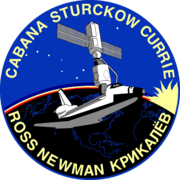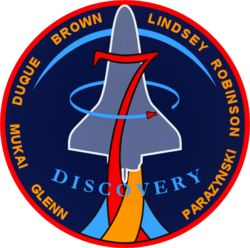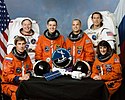STS-88
| STS-88 | |||||
 | |||||
| Uppdrag | ? | ||||
|---|---|---|---|---|---|
| Rymdfärja | Endeavour (13)[1] | ||||
| NSSDC-ID | 1998-069A[2] | ||||
| Färdens tid | 11 dagar, 19 timmar, 18 minuter, 47 sekunder | ||||
| Uppskjutning | |||||
| Startplats | Startplatta 39A vid Kennedy Space Center i Florida | ||||
| Start | 4 december 1998 3:35:34 a.m. EST (8:35:34 GMT) | ||||
| Landning | |||||
| Landningsplats | KSC runway 15 | ||||
| Landning | 15 december 1998, KSC 10:53 p.m. EST | ||||
| Omloppsbana | |||||
| Varv | 185 st[3] | ||||
| Apogeum | 401 km | ||||
| Perigeum | 388 km | ||||
| Banlutning | 51,6° | ||||
| Sträcka | 8,7 miljoner km | ||||
| Rymdpromenad | |||||
| Antal | 3 st | ||||
| Total tid | 21 timmar, 22 minuter | ||||
| Dockning | |||||
| Rymdstation | ISS | ||||
| Dockning | 7 december 1998, 02:07 UTC | ||||
| Dockningsport | Zarya, fram (via PMA-2, Unity och PMA-1) | ||||
| Urdockning | 13 december 1998, 20:24:30 UTC | ||||
| Tid dockad | 6 dagar, 18 timmar, 17 minuter | ||||
| Besättning | |||||
| Befälhavare | Robert D. Cabana (4) | ||||
| Pilot | Frederick W. Sturckow (1) | ||||
| Uppdragsspecialister | Nancy J. Currie (3) Jerry L. Ross (6) James H. Newman (3) Sergej Krikaljov (4) Ryssland | ||||
 | |||||
| Kronologi Rymdfärjeprogrammet | |||||
| |||||
STS-88 var ett rymdfärjsuppdrag som genomfördes i december 1998 med rymdfärjan Endeavour. Den sköts upp från Pad 39A vid Kennedy Space Center i Florida den 4 december 1998. Efter nästan tolv dagar i omloppsbana runt jorden återinträdde rymdfärjan i jordens atmosfär och landade vid Kennedy Space Center.
Flygningen gick till Internationella rymdstationen (ISS).
Flygningens mål var att leverera den amerikanska modulen Unity och två Pressurized Mating Adapter till rymdstationen.
Rymdpromenader
Under flygningens tre rymdpromenader installerades den amerikanska Unity-modulen.
Statistik
Besättning
- Robert D. Cabana (4), befälhavare
- Frederick W. Sturckow (1), pilot
- Nancy J. Currie (3), uppdragsspecialist
- Jerry L. Ross (6), uppdragsspecialist
- James H. Newman (3), uppdragsspecialist
- Sergej Krikaljov (4), uppdragsspecialist
Väckningar
Under Geminiprogrammet började NASA spela musik för besättningar och sedan Apollo 15 har man varje "morgon" väckt besättningen med ett musikstycke, särskilt utvalt antingen för en enskild astronaut eller för de förhållanden som råder.
| Dag | Låt | Artist/Kompositör | Spelad för |
|---|---|---|---|
| 2 | "Get Ready" | The Temptations | |
| 3 | "Anchors Aweigh" | Charles A. Zimmermann | |
| 4 | "Over the Rainbow" | Judy Garland | Robert D. Cabana |
| 5 | "Jerry the Rigger" | old Celtic song | Jerry L. Ross |
| 6 | "Streets of Bakersfield" | Dwight Yoakam | Frederick W. Sturckow |
| 7 | "Floating in the Bathtub" | James H. Newman | |
| 8 | "God Bless the U.S.A." | Lee Greenwood | Nancy J. Currie |
| 9 | "Trepak" | Pyotr Ilyich Tchaikovsky | Sergej Krikaljov |
| 10 | "Hound Dog" | Elvis Presley | |
| 11 | "Goodnite, Sweetheart, Goodnite" | The Spaniels | |
| 12 | "I Got You (I Feel Good)" | James Brown | |
| 13 | "Ride of the Valkyries" | Richard Wagner |
Se även
Referenser
- ^ NASA Space Shuttle Launch Archive Arkiverad 6 juni 2011 hämtat från the Wayback Machine., läst 28 juli 2016.
- ^ ”NASA Space Science Data Coordinated Archive” (på engelska). NASA. https://nssdc.gsfc.nasa.gov/nmc/spacecraft/display.action?id=1998-069A. Läst 22 mars 2020.
- ^ Manned Astronautics - Figures & Facts Arkiverad 4 mars 2016 hämtat från the Wayback Machine., läst 28 juli 2016.
Externa länkar
 Wikimedia Commons har media som rör STS-88.
Wikimedia Commons har media som rör STS-88.
| ||||||||
| |||||||||||||||||||||||||||||||
| ||||||||||||||||||||||||||||||||
Media som används på denna webbplats
The STS-95 patch, designed by the crew, is intended to reflect the scientific, engineering, and historic elements of the mission. The Space Shuttle Discovery is shown rising over the sunlit Earth limb, representing the global benefits of the mission science and the solar science objectives of the Spartan Satellite. The bold number '7' signifies the seven members of Discovery's crew and also represents a historical link to the original seven Mercury astronauts. The STS-95 crew member John Glenn's first orbital flight is represnted by the Friendship 7 capsule. The rocket plumes symbolize the three major fields of science represented by the mission payloads: microgravity material science, medical research for humans on Earth and in space, and astronomy.
Designed by the crew members, this patch commemorates the first assembly flight to carry United States-built hardware for constructing the International Space Station (ISS). This flight's primary task is to assemble the cornerstone of the Space Station: the Node with the Functional Cargo Block (fgb). The rising sun symbolizes the dawning of a new era of international cooperation in space and the beginning of a new program: the International Space Station. The Earth scene outlines the countries of the Station Partners: the United States, Russia, those of the European Space Agency (ESA), Japan, and Canada. Along with the Pressurized Mating Adapters (PMA) and the Functional Cargo Block, the Node is shown in the final mated configuration while berthed to the Space Shuttle during the STS-88/2A mission. The Big Dipper Constellation points the way to the North Star, a guiding light for pioneers and explorers for generations. In the words of the crew, "These stars symbolize the efforts of everyone, including all the countries involved in the design and construction of the International Space Station, guiding us into the future."
In this illustration, a SpaceX Crew Dragon spacecraft approaches the International Space Station for docking. NASA is partnering with Boeing and SpaceX to build a new generation of human-rated spacecraft capable of taking astronauts to the station and expanding research opportunities in orbit. SpaceX's upcoming Demo-1 flight test is part of NASA’s Commercial Crew Transportation Capability contract with the goal of returning human spaceflight launch capabilities to the United States.
Författare/Upphovsman: Pascal (Flickr user: pasukaru76), Licens: CC0
Vostok spacecraft replica at the Technik Museum Speyer, Germany.
Backdropped by a blue and white Earth, this close-up view features the Soyuz TMA-6 spacecraft approaching the International Space Station (ISS). Onboard the spacecraft are cosmonaut Sergei K. Krikalev, Expedition 11 commander representing Russia's Federal Space Agency; astronaut John L. Phillips, NASA ISS science officer and flight engineer; and European Space Agency (ESA) astronaut Roberto Vittori of Italy. The Soyuz linked to the Pirs Docking Compartment at 9:20 p.m. (CDT) on April 16, 2005 as the two spacecraft flew over eastern Asia. The docking followed Friday’s launch from the Baikonur Cosmodrome in Kazakhstan.
Designed by the crew members, this is the mission insignia for the STS-96 space flight, the second Space Shuttle mission dedicated to the assembly of the International Space Station (ISS). The crew patch highlights the major themes of the Station Program: Earth-directed research, the advancement of human space exploration, and international cooperation. The Space Shuttle Discovery is depicted shortly after reaching orbit as the crew prepares to carry out the first docking with the new Station. At this early stage in its construction, ISS consists of two modules: Zarya and Unity, shown orbiting Earth. The triangular shape of the patch represents building on the knowledge and experience of earlier missions, while the three vertical bars of the astronaut emblem point toward future human endeavors in space. The five-pointed star that tops the astronaut emblem in this depiction is symbolic of the five space agencies participating in the development of ISS: NASA, the Russian Space Agency, the European Space Agency, the National Space Development Agency of Japan, and the Canadian Space Agency. The blend of red, white, and blue is a tribute to the nationalities of the crew members who are from the United States, Canada, and Russia.
STS088(S)002 (November 1998):
Five NASA astronauts and a Russian cosmonaut assigned to the STS-88 mission, scheduled for an early December launch, take time out from their busy training agenda for a crew portrait. Seated in front are Sergei K. Krikalev, a mission specialist representing the Russian Space Agency (RSA), and astronaut Nancy J. Currie, mission specialist. In the rear, from the left, are astronauts Jerry L. Ross, mission specialist; Robert D. Cabana, mission commander; Frederick W. Sturckow, pilot; and James H. Newman, mission specialist.Rotated and color enhanced version of original (ISS013-E-48788 (6 July 2006) --- The Space Shuttle Discovery approaches the International Space Station for docking but before the link-up occurred, the orbiter went through a series of inspection photos by station crew to inspect the vehicle for any damage to its Thermal Protection System. This was known as the Rendezvous Pitch Maneuver and was implemented after the Columbia Disaster in 2003. The Leonardo Multipurpose Logistics Module can be seen in the shuttle's cargo bay. Discovery docked at the station's Pressurized Mating Adapter 2 at 9:52 a.m. CDT, July 6, 2006.)













